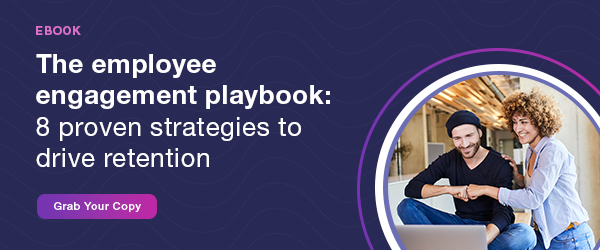December 30, 2024
7 Min. Read

How to Improve Employee Engagement and Retention Through L&D
According to Gartner, U.S. annual voluntary job turnover jumped nearly 20% in 2022, with 37.4 million employees quitting their jobs compared to 31.9 million pre-pandemic. This trend is further complicated by the approximately 11.5 million unfilled U.S. job openings reported by FRED in Q1 of 2022. Perhaps most concerning is Gallup’s finding that employee engagement saw its first annual decline in a decade, dropping from 36% in 2020 to 34% in 2021.
Research also shows that 48% of American workers would switch jobs for more skills training opportunities, highlighting the importance of learning programs in talent acquisition and retention. This is particularly true for younger workers, with Gallup reporting that 66% of employees ages 18-24 rank learning new skills as their third most crucial job benefit, after health insurance and disability benefits. For businesses and employees alike, upskilling and reskilling programs could make all the difference.
Organizations can leverage L&D as a way to improve employee engagement in three critical areas:
- Job Preparedness: Comprehensive onboarding and ongoing learning opportunities prime employees for success on the job and demonstrate your commitment to employee growth from day one.
- Talent Retention: A robust learning program signals to candidates that your organization invests in employee development, making you more attractive to top talent.
- Career Development: Access to continuous learning and development opportunities creates strong incentives for employees to build long-term careers within your organization.
Implementing a robust L&D program supported by innovative learning management technology is the key to unlocking employee potential. This program should elevate training to encompass mobile learning, microlearning, continuous development, and social collaboration while delivering measurable business results. Read on to learn seven ways to improve employee engagement, drive retention, and boost business performance.
1. Use Mobile Learning to Engage Employees Wherever They Are
PwC research indicates 40% of employees are dissatisfied with their current mobile learning options at work, with mobile accessibility in higher demand than ever before. This gap between employee expectations and reality presents a significant opportunity for organizations to upgrade their learning technology.
In today’s hybrid work environments, where employees regularly switch between office, remote, and on-field worksites, seamless cross-device learning experiences are non-negotiable. When employees can effortlessly transition between desktop and mobile devices, they’re more likely to engage with training materials during natural breaks, leading to higher completion rates and better knowledge retention.
40% of employees are dissatisfied with their current mobile learning options at work.
PwC
The importance of an intuitive, engaging mobile learning interface extends beyond mere convenience. When learning platforms incorporate gamification elements and varied multimedia content into their mobile experiences, they tap into fundamental principles of adult learning psychology and help their employees learn better. This approach also acknowledges that different employees prefer different modalities—video, interactive exercises, or text-based content—and caters to all learning styles.
A Mobile Learning App:
- Enables learning during natural workflow breaks
- Supports multiple learning styles with varied content formats
- Enhances engagement through gamification elements
- Makes learning more enjoyable and less of a “task”
2. Create Microlearning to Deliver Training in Bite-Size Chunks
According to Brookings, millennials now comprise over half of the American workforce. These younger employees are often more digitally savvy but tend to have shorter attention spans, making microlearning particularly effective in keeping them engaged.
As employees work through short learning modules, they experience a sense of accomplishment and instant gratification, encouraging continued engagement and participation. Microlearning allows targeted training to bridge performance gaps, while the brief format enhances knowledge retention. The content is mobile-friendly, accessible anywhere and anytime, and the format proves cost-effective for organizations.
Creating effective microlearning content requires a thoughtful approach that begins with understanding specific employee needs. Content should be concise and focused yet comprehensive enough to deliver meaningful value. Organizations often find success by incorporating various formats, from short videos to infographics and podcasts, while ensuring content includes real-world examples that employees can relate to daily work. Interactive elements and links to related content provide opportunities for deeper learning.
3. Build a Culture of Continuous Learning to Provide Opportunities for Growth
The foundation of a workplace culture that values continuous learning rests on three key pillars: empowering employees to explore learning opportunities, remaining agile and adaptive to change, and demonstrating organizational support for growth and development. When these elements come together, they nurture both individual and organizational growth.
Building a learning-focused company culture requires intentionality and ongoing internal support. Organizations must provide personalized learning experiences aligning with individual career goals and preferences. It’s crucial to create and reinforce good learning habits through continued encouragement and greater accessibility.
Perhaps most importantly, building a culture of continuous learning requires dedicated leadership. Many organizations are now developing specific roles—such as Chief Learning Officer—to champion these initiatives, ensure they remain aligned with business objectives, and meet employee needs.
4. Harness the Power of Personalized Learning so Learning Feels Tailored and Relevant
L&D professionals are increasingly moving away from traditional one-size-fits-all training programs in favor of more personalized learning approaches. Emerging technologies like artificial intelligence (AI) and adaptive learning enable organizations to distribute targeted learning tailored to individual performance, preferences, and goals like never before. The technology allows organizations to develop customized career paths that align individual aspirations with organizational needs, creating a win-win scenario for employee engagement and business success.
By leveraging AI-powered platforms, L&D professionals can automatically identify skill gaps and create dynamic learning paths that adapt to each employee’s progress. This enables L&D teams to deliver more dynamic learning journeys that evolve with each learner’s needs. The technology provides granular insights into learning patterns and preferences, allowing L&D teams to refine their content strategy and delivery methods.
When integrated with performance data and career development frameworks, this approach enables L&D departments to align career development with broader organizational planning, creating a measurable impact on employee engagement and business outcomes.
5. Lean into Social and Collaborative Learning to Create “Water Cooler” Moments
Research indicates that 90% of employee learning occurs through informal, hands-on experience and peer learning, leading many businesses to prioritize social and collaborative learning.
Modern learning platforms facilitate social learning through various features that create rich, interactive learning environments. Group collaboration tools enable teams to learn together, while discussion boards foster broader knowledge sharing across the organization. Instant notifications inform employees of new learning opportunities, and regular polls and surveys ensure employees have a say in learning program development.
Gamification elements add an extra layer of engagement, with leaderboards and reward systems creating friendly competition that encourages continued participation. Goal-setting helps employees visualize their progress and celebrate achievements, while social recognition reinforces the value of learning within the organizational culture.
90% of employee learning occurs through informal, hands-on experience and peer learning.
Training Industry
6. Understand How to Measure Learning ROI to Optimize the Engagement Strategy
The business case for L&D remains strong, with Accenture research revealing that organizations can achieve a remarkable 353% ROI on learning programs, receiving $4.53 in return for every dollar invested. However, measuring the true impact of learning requires a systematic approach that goes beyond traditional metrics like course completion rates.
Successful measurement of learning ROI begins with clearly defined training goals that align with business objectives. Organizations must select relevant KPIs that meaningfully reflect both learning outcomes and business impact. Carefully choosing these criteria ensures that the correct data is captured and the correlation analysis between learning metrics and business performance provides actionable insights.
7. Select the Right Learning Technology Platform to be Able to Engage Employees at Scale
The success of your L&D initiatives largely depends on selecting technology that supports comprehensive learning strategies. Your learning platform should feature a mobile-first design that meets employees where they are and robust microlearning capabilities that facilitate quick learning within the flow of work.
Businesses should gather input from their L&D teams, who understand the daily realities of the organization’s learning programs. Technical requirements must be evaluated alongside existing systems and infrastructure, ensuring seamless integration with current workflows. Selecting a technology provider who is a trustworthy partner in your L&D efforts is essential, as is providing guidance and expertise whenever required.
The future of work demands new approaches to employee engagement and development. By implementing these seven ways to improve employee engagement with appropriate technology support, organizations can build more engaged, skilled, and motivated workforces while achieving measurable returns on their L&D investments.




